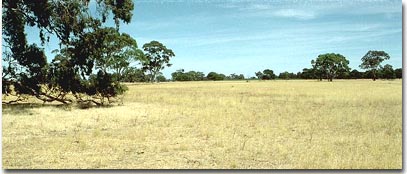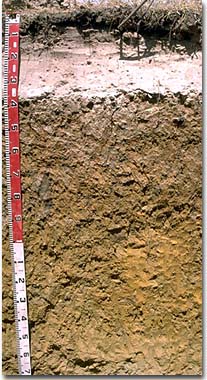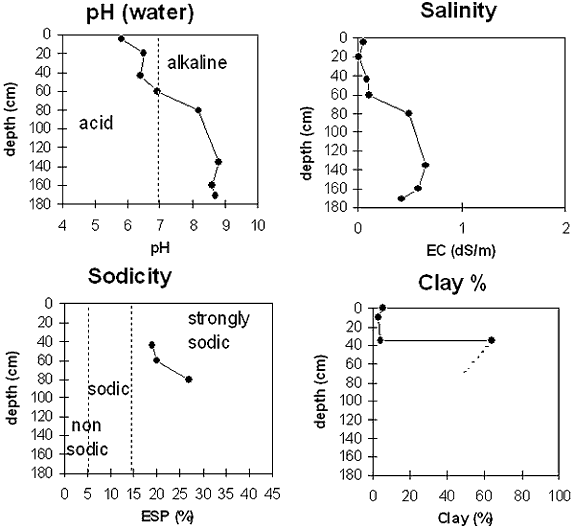Site WW14
Location: Lillimur South
Australian Soil Classification: Vertic, Mottled-Mesonatric, Grey SODOSOL
Northcote Factual Key: Dy5.43
Great Soil Group: solodic
 Site WW14 Landscape |
General Landscape Description: This soil occurs in the lower slope of the landscape. It often forms a transition to areas of deeper sands which occur on crests and upper slopes above this unit (often greater than 1.5 metres on the crests). Dry heath vegetation is associated with this map unit i.e. Stringbarks, Grass Trees and Tea Trees are indicative of the deeper sands.
Soil Profile Morphology:
Surface Soil
| A1 A2 | 0-10 cm 10-35 cm | Very dark greyish brown (10YR3/2) sand (organic); weak consistence when dry; pH 5.8; abrupt transition to: Pink (7.5YR7/4) sand; conspicuously bleached when dry; structureless; weak consistence when dry; a few subrounded ferruginised (‘buckshot’) gravels; thin (2-5 mm) capping directly above the clay, with a very strong consistence when dry; pH 6.5; sharp transition to: |  Site WW14 Profile |
| Subsoil | |||
| B21 | 35-70 cm | Pale brown (10YR6/3) changing at depth to yellowish brown (10YR5/6) medium clay; coarse distinct red, light grey and yellowish brown mottles are abundant; moderate blocky structure (peds 20-50 mm), parting to moderate polyhedral structure (peds 10-20 mm) with strong polyhedral structure in patches (peds 5-10 mm); strong consistence when dry; dispersive when worked; pH 6.4; clear transition to: | |
| B22 | 70-120 cm | Yellowish brown (10YR5/6) medium clay; with dark stains down prism faces; moderate to strong prismatic structure (peds 50-100 mm), parting to moderate blocky structure (peds 20-50 mm); strong consistence when slightly moist; pockets of clayey sand occur; pH 8.2; gradual transition to: | |
| B23 | 120-150 cm | Yellow (10YR7/8) medium clay; strong lenticular structure in patches; firm to very firm consistence when moderately moist; pH 8.8; gradual transition to: | |
| B31 | 150-170 cm | Brownish yellow (10YR6/6) sandy clay (with patches of grey); firm consistence when moderately moist; pH 8.6; gradual transition to: | |
| B32 | 170-200+ | Pinkish grey (7.5YR6/2) sandy clay loam; with veins of bluish grey (5B6/1) clay and red flecks of quartz sand; firm consistence when moderately moist; pH 8.7. | |
pH | Salinity | Internal Drainage | Hydro-phobicity | |||
Surface (A1 horizon) | moderately acid | very low | non-sodic | - | - | medium |
Subsoil (B21 horizon) | slightly acid | very low | strongly sodic | nil1 | imperfectly drained2 | - |
Deeper subsoil (at 1 metre) | moderately alkaline | low-medium | strongly sodic | strong1 | - | - |
2 Most impeding horizon of the profile that will affect plant growth.

Key Profile Features:
|
Feature | Result | Management Prescription |
| Sandy surface soil. |
| Dryland cropping.
|
| Hydrophobic surface soil. |
|
|
| Acidic surface soil. |
|
|
| Bleached A2 horizon. |
| Dryland cropping.
|
| Strong textural contrast between surface soil and subsoil (duplex). |
|
|
| Sodic clay subsoil. |
|
|
| Mottled subsoil. |
|
|
| Dispersion when reworked. |
|
|
Land Suitability Rating Table:
LAND USE | SUITABILITY CLASS | MAJOR LIMITING COMPONENT |
| Wheat | 2 | Climate, landscape, soil |
| Canola | 2 | Climate, landscape, soil |
| Chickpeas | 3 | Climate, soil |
| Lentils | 3 | Climate, soil |
| White clover seed | 2 | Climate, landscape, soil |
| Lucerne for seed production | 3 | Soil |
| Viticulture | 3 | Soil |
| Apples | 2 | Climate, landscape, soil |
| Potatoes | 3 | Landscape, soil |
| Carrots | 3 | Landscape, soil |
| Onions | 3 | Landscape |
| Sweet corn | 3 | Soil |
| Radiata Pine | 2 | Climate, landscape, soil |
| Blue Gum | 2 | Climate, landscape, soil |
Land Suitability Assessment and Primary Limitations:
| Wheat | Climate | 2* | Moderate to high frost risk, moderate to high rainfall. |
| Landscape | 2 | Gully erosion hazard. | |
| Soil | 2 | Clay subsoil, slightly impeded internal drainage, hydrophobicity. | |
| Canola | Climate | 2# | Moderate to high frost risk, slightly high rainfall. |
| Landscape | 2 | Gully erosion hazard. | |
| Soil | 2 | Slightly impeded internal drainage, hydrophobicity. | |
| Chickpeas | Climate | 3 | High rainfall. |
| Landscape | 2 | Gully erosion hazard, wind erosion hazard. | |
| Soil | 3 | Sandy surface soil, impeded internal drainage. | |
| Lentils | Climate | 3 | High rainfall. |
| Landscape | 2 | Gully erosion hazard, wind erosion. | |
| Soil | 3 | Sandy surface soil, impeded internal drainage. | |
| White clover seed | Climate | 2+ | Moderate frost risk, moderate to high rainfall. |
| Landscape | 2 | Gully erosion hazard. | |
| Soil | 2 | Slightly impeded internal drainage, hydrophobicity. | |
| Lucerne for seed production | Climate | 2 | Moderate frost risk. |
| Landscape | 2 | Gully erosion hazard. | |
| Soil | 3 | Impeded internal drainage. | |
| Viticulture | Climate | 2# | Moderate to high frost risk. |
| Landscape | 2 | Gully erosion hazard. | |
| Soil | 3 | Impeded internal drainage. | |
| Apples | Climate | 2# | Moderate to high frost risk, slightly high mean maximum January temperature. |
| Landscape | 2 | Gully erosion hazard. | |
| Soil | 2 | Slightly impeded internal drainage, hydrophobicity. | |
| Potatoes | Climate | 2 | Slightly high mean maximum January temperature. |
| Landscape | 3 | Gully erosion hazard. | |
| Soil | 3 | Impeded internal drainage. | |
| Carrots | Climate | 1 | No major limitation. |
| Landscape | 3 | Gully erosion hazard. | |
| Soil | 3 | Impeded internal drainage. | |
| Onions | Climate | 2 | Moderate frost risk. |
| Landscape | 3 | Gully erosion hazard. | |
| Soil | 2 | Sandy surface soil, slightly impeded internal drainage, hydrophobicity. | |
| Sweet corn | Climate | 2 | Slightly low mean monthly temperature (October - March). |
| Landscape | 2 | Gully erosion hazard. | |
| Soil | 3 | Sandy surface soil. | |
| Radiata Pine | Climate | 2** | Moderate to low rainfall, slightly high mean maximum January temperature. |
| Landscape | 2 | Gully erosion hazard. | |
| Soil | 2 | Slightly impeded internal drainage. | |
| Blue Gum | Climate | 2** | Moderate to low rainfall, slightly high mean maximum January temperature . |
| Landscape | 2 | Gully erosion hazard. | |
| Soil | 2 | Slightly impeded internal drainage. |
# Some areas may be higher frost risk.
+ Some areas may have higher rainfall.
** Some areas may have lower rainfall.
Profile Described By: David Rees, Nathalie Baxter (January 1997).


